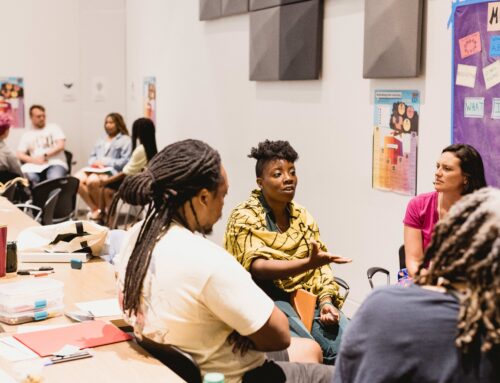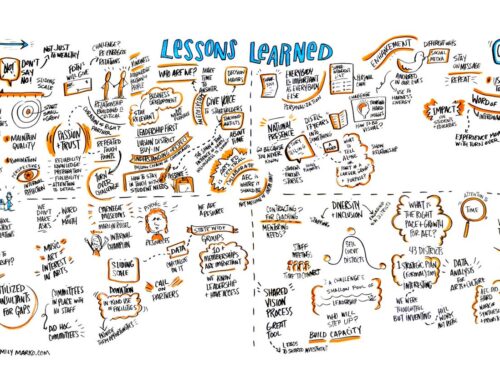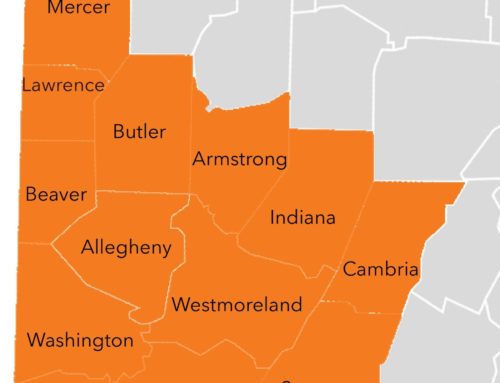 Interview with TeamBuilders Group
Interview with TeamBuilders Group
AEC recently began corresponding with The TeamBuilders Group, a peer organization working with PK-12 teachers of all kinds throughout the region. Founded in 2016, TeamBuilders has deep roots in Pittsburgh-area schools and draws from a background of both research and classroom experience.
The interview below was conducted via email during September-October 2018, and has been lightly edited for style and clarity.
Tell us a little bit about your backgrounds and how The TeamBuilders Group came about.
Jordan Lippman: In addition to my role at TeamBuilders, I am an independent researcher. In graduate school, I studied to become an experimental research psychologist focused on applying learning theory within classrooms. My academic colleague and writing partner, Dr. Trina Kershaw at UMass, and I recently published a peer-reviewed paper in Instructional Science. I also lead the Collaboration Nation study of K-12 collaboration instruction and assessment practices with several mission-driven orgs. And, I have the honor of assisting with the SW PA Personalized Learning Network, and serving on the Remake Learning NextGen Professional Learning Working Group.
Recently, though, I have drunk the Improvement Science KoolAid and thanks to Kenda and Mary, I have become more humanistic in my approach to educational innovation. It is clear to me–now–that academic ideas are only one part of the story of educational improvement. The rest of the story is informed by knowledge of the system and by educator insights about practice, including student data. My commitment to creating conditions for equitable collaboration in schools is informed by my lifelong struggles with learning disabilities and ADHD, by my cultural tradition of Judaism, and the practical consequences of inequitable collaboration on student learning.
Kenda Hammer: I joined The TeamBuilders Group in August 2017 and serve as Head Coach. While this position in a startup is new for me, my career of 35+ years in the Fox Chapel Area School District (FCASD) has prepared me for our critical task of transforming student lives and communities through service-oriented project-based learning (PBL). With a B.S. in Child Development/Early Childhood Ed and M.A. in Elementary/Early Childhood Ed, I embarked upon my career in kindergarten classrooms. My love of teaching, aligned with my desire to understand more deeply, has always compelled me to investigate the “what” of real problems and the “how” of success. My writing these days about collaborative learning, as a teacher-researcher, follows three key initiatives across my career: (1) Founding the FCASD full-day kindergarten initiative, including PD for regional capacity-building among early educators and arts specialists; (2) Founding the FCASD Family Literacy Center with guest artist mini-residencies; (3) Facilitating the Early Learning Consortium that created a transformative learning community for PK-3 teachers and support specialists over the course of 18 Forms and 9 years.
Other team members include Mary Claire Arena, who is an experienced educator and certified Literacy Specialist. With a B.A. in Elementary Ed from Loyola University of Maryland and a M.A. in Literacy from the University at Buffalo, she spent 9 years teaching K-2 classrooms. When she moved to Pittsburgh in 2013, she was inspired by the educational culture, and value placed on student-centered approaches by TeamBuilders.
Though TeamBuilders isn’t specifically arts-focused, you bring arts teachers into leadership teams for your work with schools. What difference does that make for the educators you work with?
JL: We initiate equitable collaboration by including diverse stakeholders and interests on the TBG Leadership Working Groups we co-create to steer our improvement work with each partner. Our process of customizing the TeamBuilders Model of Equitable Collaboration for each school involves modeling for/with faculty what students will have to do. First, we ask questions and listen. Second, we seek to make visible current practices and competencies as we create a common vocabulary and shared understanding across grade levels, academic subjects, and the arts.
TeamBuilders: Throughout this process we make connections between culture and pedagogy. We relate what classroom teachers are doing to what the arts teachers are doing with their students. Not only does this allow the collaborative culture to expand beyond the classroom walls, but also it creates stronger pedagogy.
Did you always involve arts teachers in your professional learning opportunities, or is that a change you made later on?
JL: I have to say, it is different for each client. Sometimes the hook is an arts-related initiative like a Makerspace and other times arts educators play a role when we gather all stakeholders to establish a common vocabulary for discussing and reflecting upon collaboration. The perspective of arts educators is critical to both orders!
TeamBuilders: To successfully create conditions for equitable collaborative learning within a school, we have recently found that insights from the often industry-driven instructional practices of arts educators can enrich regular classroom instructional practices. For example, Music teachers may use their experience practicing in a band to help them structure the student experiences as they learn to play an instrument. These authentic practices often contain insights about how to scaffold group behavior to produce magnificent works of art.
How have the arts impacted your lives and practices?
JL: When I was born, my mother, Sherri Lippman was an arts educator in Paterson, NJ (think Joe Clark and Lean on Me) – her students volunteered to escort her to and from her car every day so she would be safe. Art was everywhere around me — Broadway shows, museums, and concerts; and art on every wall in our home. Some family art — my Mom also ran a custom clothing shop out of our basement and recently was a Docent at the MET in NYC; my grandfather Roy Horton was a graphic designer for Manischewitz in the 50’s; and my Aunt Jane is a practicing artist and former Art teacher. While my family includes art educators and professional artists, and I had an early artistic accomplishment of a state poetry award in 5th grade, I became a researcher and designer whose canvas has become entrepreneurship. I still find inspiration within the arts for activities that quickly push people into an ‘uncomfortable’ place where they can be authentic, empathetic, and collaborative.
KH: I grew up in a family of accomplished performing musicians. At 13, I began a musical partnership with my future husband, Dave Hammer. We literally made music together during our earliest dating days, and then embraced our own family of musicians after working professionally for nearly a decade. I taught with my singing voice as a captivating, unobtrusive way to engage students’ attention, while Dave progressed to record the acclaimed children’s CD, Time to Sing with nationally recognized professional partners like Michael Moritz, 1997-2001 Musical Director of Mister Rogers’ Neighborhood. With our daughter, Katie, we nurtured the love of piano in jazz ensembles and musicals. Then came private study with Phil VanOuse, and nine years of marching band from the foundational lower brass on baritone horn and drum major. Our son, Brad, entertained from his earliest days through singing, playing trombone as taught privately by Carl Jackson, and as a touring singer/songwriter in the alternative rock genres who led four coast-to-coast trips, signed to the MISRA label. Occasionally I’m their roadie, while juggling duties of chairing the BOD for Belle Voci, a local Intergenerational Women’s Choir.
What do you consider the greatest barriers to teacher collaboration? Do the arts help in overcoming these barriers?
JL: I am starting to think that fear, shame, and rigidity are the most challenging barriers to collaboration. These walls begin to fade away with repeated practice of TBG Strategies, an inclusive working group with strong administrative support, and common planning time for coaching and professional learning. Some teachers (rightfully) do not want to be judged for “failing” if they take risks. Interestingly, I think the Lakoffian metaphor of the “Independent Artisan” (Huberman, 1993) – a source of strength and inspiration – may subconsciously interfere with teachers welcoming others into their practice. A new metaphor of the “collectively responsible” educator is needed.
A common implicit misconception of many high-ability individuals that prevents equitable collaboration in school – even among teachers – is the idea that they need to do all the work. Rather than blocking others from participating out of fear, it would be better to practice leadership and find ways to engage everyone.
A surprising barrier may be the Cooperative Learning movement of the 90’s that introduced many educator-driven group work structures. Experienced teachers are able to successfully engage students in developmentally appropriate “learning centers” and “divide-and-conquer” tasks (a lab report where people work independently on parts that are pasted into a final product). But these are more parallel play than messy and loud collaborative experiences. Sounds like an art studio, huh? Even ‘innovative’ educators are at a disadvantage because many EdTech products also contain implicit misconceptions – group discussion tools, peer-study apps, and other socially-oriented technologies actually promote conversation or coordination not collaboration.
As you may have inferred from the preceding paragraphs, I sometimes experience barriers when I am trying to communicate my ideas. Luckily, Kenda, Mary, and the TeamBuilders family – including many local educators and Partners – have patiently worked to adapt my ideas for use in real schools. Within the last year, graphic designer Kathryn Gauer joined our team, and her creativity has allowed us to organize, visualize, and communicate our understanding of collaboration.
TeamBuilders: Educators and students often look to us to tell them what to do. But, this type of “helping” – that tells people what to do – is not what models for educators and students. Instead, we share our perspective of co-creation: we learn about current educator practices to build on their strengths and connect them with resources. TeamBuilders Strategies give educators guidance for skill-building with the T.R.U.S.T. model and for scaffolding Team Work (relationship building) and Task Work (creative problem solving). For example, our collaborative coaching model guides educators to experiment with NSRF Protocols, Project Zero visible thinking routines, and Luma Institute human-centered design strategies. Then, we ask educators to document and reflect on their practice.
One of the greatest barriers, however, is expanding teacher collaboration beyond grade-level or department teams. Including Art Educators accelerates the culture- and capacity-building process.
In your opinion, what makes arts education, and PK-12 education more broadly, unique in the Pittsburgh region?
JL: There is support for arts and maker education in the Pittsburgh region through organizations like the Cultural Trust, GPAC, and the institutions of higher education and public learning. Honestly, though, it’s the people that make Pittsburgh unique: Nina at Assemble, Yael at Arts Education Collaborative, and Sunnana and Ani at Remake. Many local educators have nurtured me and my company as we have evolved into an organization that is ready to give back. I am grateful for having such amazing colleagues, friends, and mentors. I appreciate how rare it is to have an organization like the Remake Learning Network to connect us all.
TeamBuilders: We feel lucky that our Partners have welcomed us to join them in creating equitable collaboration within their schools. There is great passion, talent, and promise within the faculty at each of our partners: Manchester Academic Charter School’s Middle School, Duquesne Elementary School, and the Penn Hills Charter School of Entrepreneurship.
What makes you hopeful or excited for the future of education?
TeamBuilders: We are excited to see education begin to move beyond traditional approaches and toward collaborative learning. These pedagogical strategies prepare students for their future careers and to be better citizens. We hope more leaders embrace PBL and more educators embrace the pedagogies that we’ve discussed. Like TeamBuilders itself, these Strategies create a bridge between PBL, the art room, and the traditional classroom. And, we are excited that it is easy for us to include arts educators in our working groups because that means administration also values the voices of arts educators.
–
We’d love to hear what you think. How do you understand equitable collaboration and how do you promote it? What resources do you use or need? Feel free to share your practices or otherwise send your thoughts to tiffany@teambuildersgroup.com or info@artsedcollaborative.org.






